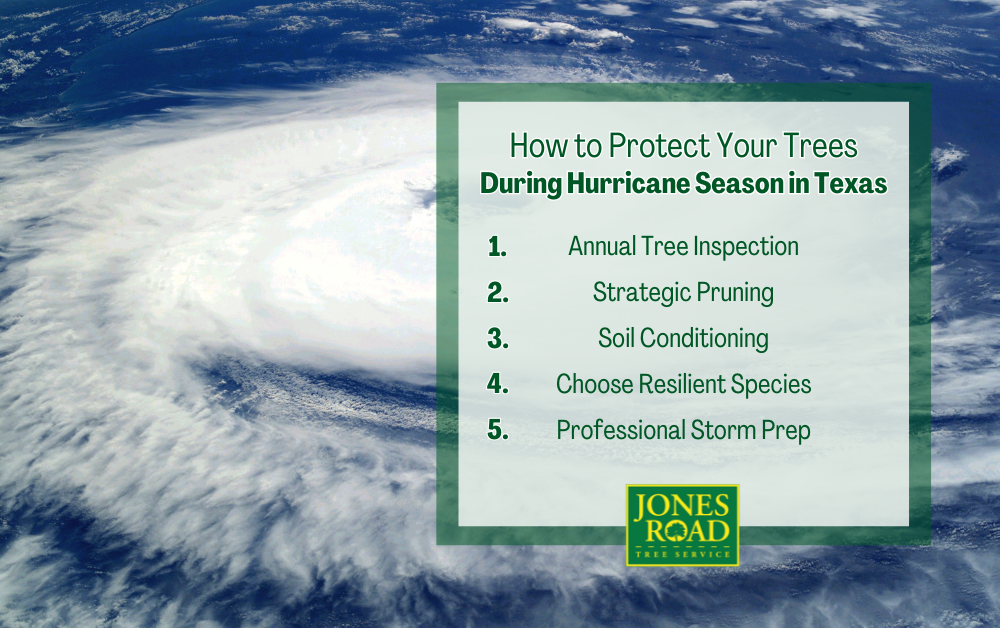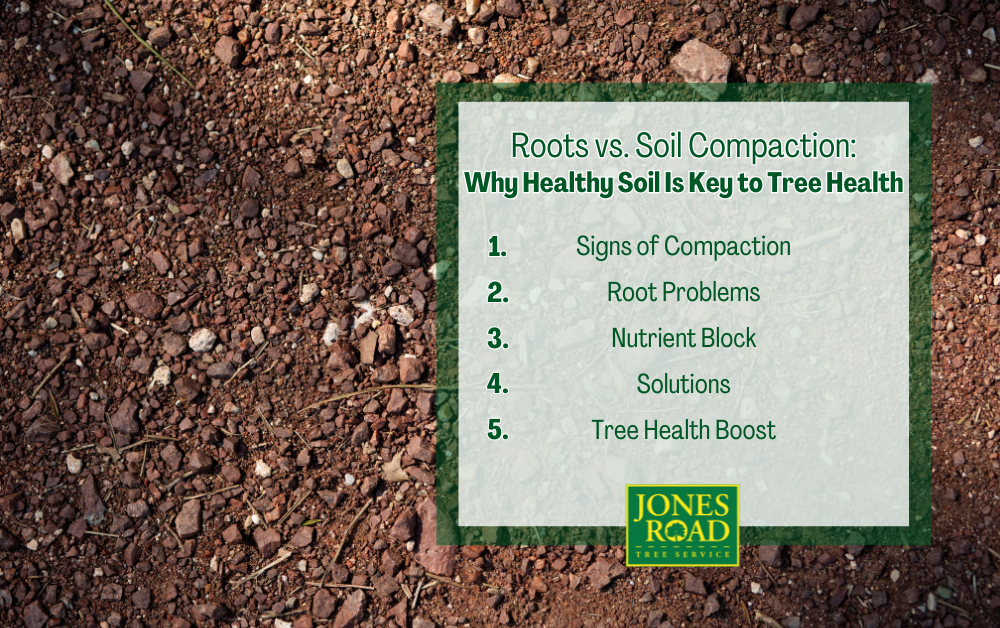Hurricane season in Texas stretches from June through November, with September often bringing the most intense storms. For homeowners in the Houston area, it’s not just about boarding up windows or stocking supplies—it’s also about preparing your landscape. Trees are especially vulnerable to strong winds, heavy rainfall, and shifting soils. Without proper preparation, even healthy trees can become hazardous. In this guide, we’ll cover how to protect your trees during hurricane season—from strategic trimming to long-term planning—so you can keep your property safe and your trees thriving.
Understanding the Risks Trees Face During Hurricane Season
Wind Damage and Uprooting
Hurricane-force winds can easily damage trees. Trees with shallow roots, poor branch structure, or dense canopies are especially vulnerable. Strong gusts can strip leaves, snap limbs, or even uproot entire trees. In particular, fast-growing and brittle trees tend to fare the worst.
You should pay special attention to:
- Trees leaning heavily in one direction
- Branches that cross or rub against each other
- Weak branch connections or large V-shaped forks
When trees fail, they not only damage your landscape—they can also strike power lines, fences, vehicles, and even homes.
Soil Saturation and Root Failure
During hurricane season, the Houston area can experience several inches of rainfall in a matter of hours. The clay-heavy soils common in this region retain water, which can reduce oxygen flow to roots and cause them to loosen their grip on the ground. This leads to instability—even for mature, seemingly healthy trees.
Signs your tree might be at risk include:
- Exposed roots
- Soil heaving around the base
- Mushy ground after storms
Root failure often goes unnoticed until a tree topples—especially after a second or third major storm in a single season.
Flying Debris and Falling Limbs
Branches weakened by disease or pests, or simply overdue for trimming, can break off and become dangerous projectiles. Even a small branch, when hurled by hurricane-force winds, can damage roofs or windows. Preventive pruning is your best defense.
Tree Preparation Starts Before the Storm
Annual Tree Health Inspection
Regular inspections are essential for spotting problems early. Certified arborists know how to identify subtle signs of disease, decay, or poor structure. Scheduling an inspection before hurricane season allows time for corrective action—whether that’s trimming, removal, or structural support.
Key areas inspected:
- Root collar for signs of decay
- Canopy density and shape
- Deadwood or overburdened limbs
- Structural defects like co-dominant stems
Getting on an annual maintenance plan ensures your trees are ready for both everyday weather and hurricane extremes.
Strategic Pruning and Thinning
Pruning helps reduce wind resistance by thinning the canopy. This allows air to pass through rather than push against the tree like a sail. Removing dead, weak, or unbalanced branches also prevents storm breakage.
Tips for effective pruning:
- Avoid over-pruning or removing large branches unnecessarily
- Focus on structural balance, especially in young trees
- Always use proper pruning techniques to avoid infection
Improper pruning can make trees more vulnerable during storms, so leave major work to professionals.
Fertilization and Soil Conditioning
Trees in urban settings often suffer from compacted soil, nutrient deficiencies, or heat stress—especially in Houston’s scorching summers. Fertilizing in spring or early summer helps trees develop stronger roots and recover from stress faster. Aerating the soil and adding compost can improve water drainage and root health.
Key benefits of fertilization before hurricane season:
- Boosts root development
- Increases disease resistance
- Strengthens limbs and trunk structure
Trees that are well-fed and properly watered are better equipped to survive extreme weather.
Choosing the Right Trees for Hurricane Resistance
Native & Wind-Resilient Trees for Houston
Native trees tend to be better adapted to local soils, humidity, and temperature fluctuations. Some are also naturally more wind-resistant. Houston homeowners should prioritize species with deep root systems and flexible limbs that can sway without breaking.
Recommended trees for hurricane resistance:
- Live Oak – Strong wood and deep roots
- Bald Cypress – Tolerates flooding and wind
- Yaupon Holly – Compact and wind-resistant
- Southern Magnolia – Strong limbs and dense foliage
- Cedar Elm – Hardy and adaptable to poor soil
Avoid species like silver maple, pecan, or water oak, which are more brittle or prone to root issues.
Long-Term Planning with Storms in Mind
Landscape design should take wind flow into account. Strategic placement of shrubs, fencing, and trees can deflect or buffer wind. Avoid monoculture tree rows, which are more prone to domino-style collapse.
Long-term strategies:
- Use multiple layers: low shrubs, small trees, large trees
- Choose slow-growing species with strong trunks
- Regularly reassess growth and spacing as trees mature
Planning ahead not only reduces hurricane damage—it also creates a healthier, more beautiful yard year-round.
What to Do When a Storm Is Coming
Last-Minute Tree Safety Checks
If a hurricane watch or warning is issued, conduct a quick walk-through of your property. Look for hanging branches, cracked limbs, or signs of instability. Remove or secure outdoor furniture, lawn tools, and decorations that could blow into your trees—or be hit by falling limbs.
Emergency checklist:
- Park vehicles away from large trees
- Tie down or remove patio items
- Avoid trimming trees yourself in high winds or rain
If you see anything concerning, call a local tree service immediately for professional evaluation.
Avoid DIY Tree Work
Hurricane prep is not the time for risky DIY pruning or removal. Chainsaws, ladders, and unstable trees are a dangerous combination—especially when you’re racing against the clock. One wrong cut can bring down a tree in the wrong direction or cause injury.
Reasons to leave it to the pros:
- Certified arborists use proper equipment and rigging
- They can assess tree stability and risk
- Emergency crews are trained for high-pressure situations
Attempting to do the work yourself may also void insurance coverage if something goes wrong.
Pre-Storm Services Offered by Jones Road Tree Service
Jones Road Tree Service offers specialized hurricane preparation, including:
- Emergency pruning and removal
- Structural bracing and cabling
- Tree health inspections
- Yard assessments for hazard trees
Our team is fully insured, experienced with Gulf Coast weather, and available for fast turnarounds during peak storm months.
Post-Storm Tree Recovery and Cleanup
Assessing Storm Damage Safely
Once the storm has passed, stay alert. Downed power lines, hanging limbs, or split trunks can still be dangerous. Don’t attempt to clear branches or debris until professionals have inspected the area.
Signs your tree needs attention:
- Major leaning or uprooting
- Cracks along the trunk
- Large limbs torn off
- Soil upheaval around the base
Even if a tree looks intact, hidden root damage or internal decay can lead to future failure.
Tree Recovery Tips
Not all damage is fatal. Many trees bounce back after a storm with the right care. Prune torn limbs cleanly, water the root zone thoroughly, and apply mulch to reduce stress. Monitor over the following weeks for signs of recovery or further decline.
Recovery tips:
- Avoid fertilizer immediately after a storm—wait until signs of regrowth
- Stake only if the tree is unstable and can be saved
- Remove broken limbs cleanly at the branch collar
Call an arborist to help determine whether a damaged tree is salvageable.
When Tree Removal Is Necessary
Some trees simply can’t be saved. If a tree is leaning dangerously, has severe trunk splitting, or has lost most of its roots, it may need to be removed.
Reasons for removal:
- Safety hazard to people or structures
- Insurance requirement
- Risk of further property damage
Jones Road Tree Service uses proper equipment, including cranes and rigging, to remove large or unstable trees without additional damage to your yard.
Why Professional Tree Care Matters in Hurricane Season
Local Experience with Houston’s Storm Patterns
Houston’s weather is unlike anywhere else. Our team has decades of experience dealing with the specific challenges trees face here—from extreme heat to flash flooding and high winds. We understand the native tree species, the soil conditions, and the timing of seasonal threats.
Licensed, Insured, and Ready to Help
Tree work is risky. Hiring a licensed and insured tree service means you’re protected if anything goes wrong. We follow industry standards and safety protocols—so you don’t have to worry about accidents, property damage, or liability.
Ongoing Maintenance Plans for Peace of Mind
We offer year-round tree care plans that include:
- Seasonal inspections
- Preventive pruning
- Fertilization and soil health care
- Emergency storm prep consultations
These plans keep your landscape looking great and your trees strong enough to stand up to whatever the season brings.
Be Proactive, Not Reactive
Hurricane season in Texas is a fact of life—but property damage doesn’t have to be. Proactive tree care is one of the smartest steps you can take to protect your home, your family, and your investment. By working with certified professionals and planning ahead, you reduce the risk of fallen trees, broken limbs, and costly repairs.
Don’t wait for the next hurricane warning. Contact Jones Road Tree Service today to schedule your pre-storm tree inspection and get your yard hurricane-ready.




